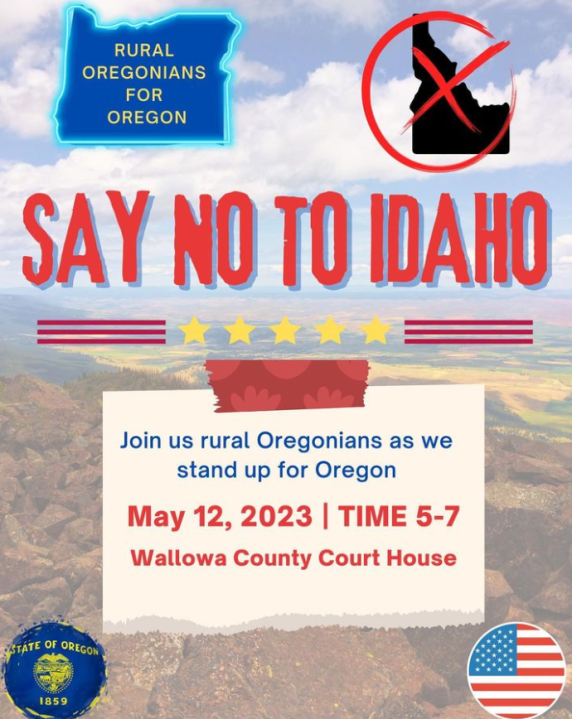PORTLAND, Ore. (KOIN) – The political group Rural Oregonians for Oregon is organizing a “Say No to Idaho” event at the Wallowa County Courthouse on May 12 in opposition of the “Greater Idaho” measure that Wallowa County voters will decide on next month.
On May 16, Wallowa County voters will choose if the county will join 11 other Eastern Oregon counties (Baker, Grant, Harney, Jefferson, Klamath, Lake, Malheur, Morrow, Sherman, Union and Wheeler) that have already voted to support a proposed separation from liberal Oregon and join the Republican-led state of Idaho. If passed, ballot measure 32-007 would require county commissioners to discuss the local public’s interest in pushing the Oregon state border west, allowing Idaho to consume roughly half the State of Oregon.

“Petition requires the Board of Commissioners meet fourth Wednesday of every February and August to discuss promoting interest of Wallowa County to relocate State Borders, and to prepare County to become part of Idaho.” the measure reads.
In a statement provided to KOIN 6, Rural Oregonians for Oregon calls for a unified fight against the “Greater Idaho” movement ahead of the May special election.
“They have not conducted an economic analysis on how they would acquire, let alone manage, 63% of Oregon,” Rural Oregonians for Oregon stated. “In fact, a preliminary analysis shows that the average Wallowa County family would earn less money as a citizen of Idaho. While there are a host of issues that we agree need to be addressed, changing the border is not the answer. We are proud Oregonians, and this is a chance for us to demonstrate our resilience and fortitude by working together.”

While the “Greater Idaho” movement has gained momentum in Eastern Oregon and the state of Idaho, where state lawmakers also passed a bill in February agreeing to engage in “Greater Idaho” talks with the state of Oregon, it remains unclear how the proposed deal would actually occur.
Rural Oregonians for Oregon plan to hold the May 12 “Say No to Idaho” rally from 5 to 7 p.m. The group’s latest updates can be found on its social media pages. Read Rural Oregonians for Oregon’s full statement below.
A statement from the group Rural Oregonians for Oregon:
In 1848 the territory of Oregon included the states of Oregon, Washington, and Idaho. Our government decided this was an unmanageable amount of land for one state, so our forefathers created three states of roughly equal size. The Greater Idaho Movement seeks to erode our founding fathers’ constitutional wishes. They have not conducted an economic analysis on how they would acquire, let alone manage, 63% of Oregon. In fact, a preliminary analysis shows that the average Wallowa County family would earn less money as a citizen of Idaho. While there are a host of issues that we agree need to be addressed, changing the border is not the answer. We are proud Oregonians, and this is a chance for us to demonstrate our resilience and fortitude by working together.
Being a resident of Idaho would be fiscally detrimental for Wallowa County citizens. The State of Idaho could not economically support Eastern Oregon, ranking sixth in the nation for states most reliant on the federal government, while Oregon is ranked 39th. Idaho takes more money from the federal government than it makes and cannot afford to support its economic expenditures, so states like Oregon, with sustainable economies, cover Idaho’s federal tax deficit year after year. Idaho’s $7.25 minimum wage does not support a livable wage for its citizens, while Wallowa County’s minimum wage is $12.50. Even with a lower income tax in Idaho, the tax burden (all taxes combined) for low and middle-class citizens will remain basically the same as Idaho’s tax burden rate is 10.7% while Oregon’s is 10.8%.
Ultimately, citizens of rural Oregon have a choice to fight for the future of our home and the Oregon we want or give up and quit. Quitting is easier, but there are generations of rural Oregonians who have the courage to fight for an Oregon that represents our collective values. We understand our community members’ frustration with not being given a seat at the table in Salem. Still, there are tangible steps we can take, such as submitting legislation to reinstate the rural policy advisory committee or even convening a rural policy committee on a county level. We don’t see Greater Idaho Movement advocates taking mitigating steps like this, but those of us who are public servants would gladly work together on policy endeavors for all rural Oregonians.
Wallowa County is a unique community home to diverse perspectives and thoughtful and hardworking people who are valuable change-makers–not pawns in our country’s two-party political game of chess. The Greater Idaho Movement is a political movement promising change for public administration issues they will never be able to deliver on–issues our communities and local elected leaders can resolve. Let’s collaborate as a community and create tangible policy proposals that describe how the State of Oregon can best serve our needs rather than relying on another State’s hidden political agenda to solve the issues we’re capable of changing.
Sincerely,
Rural Oregonians for Oregon